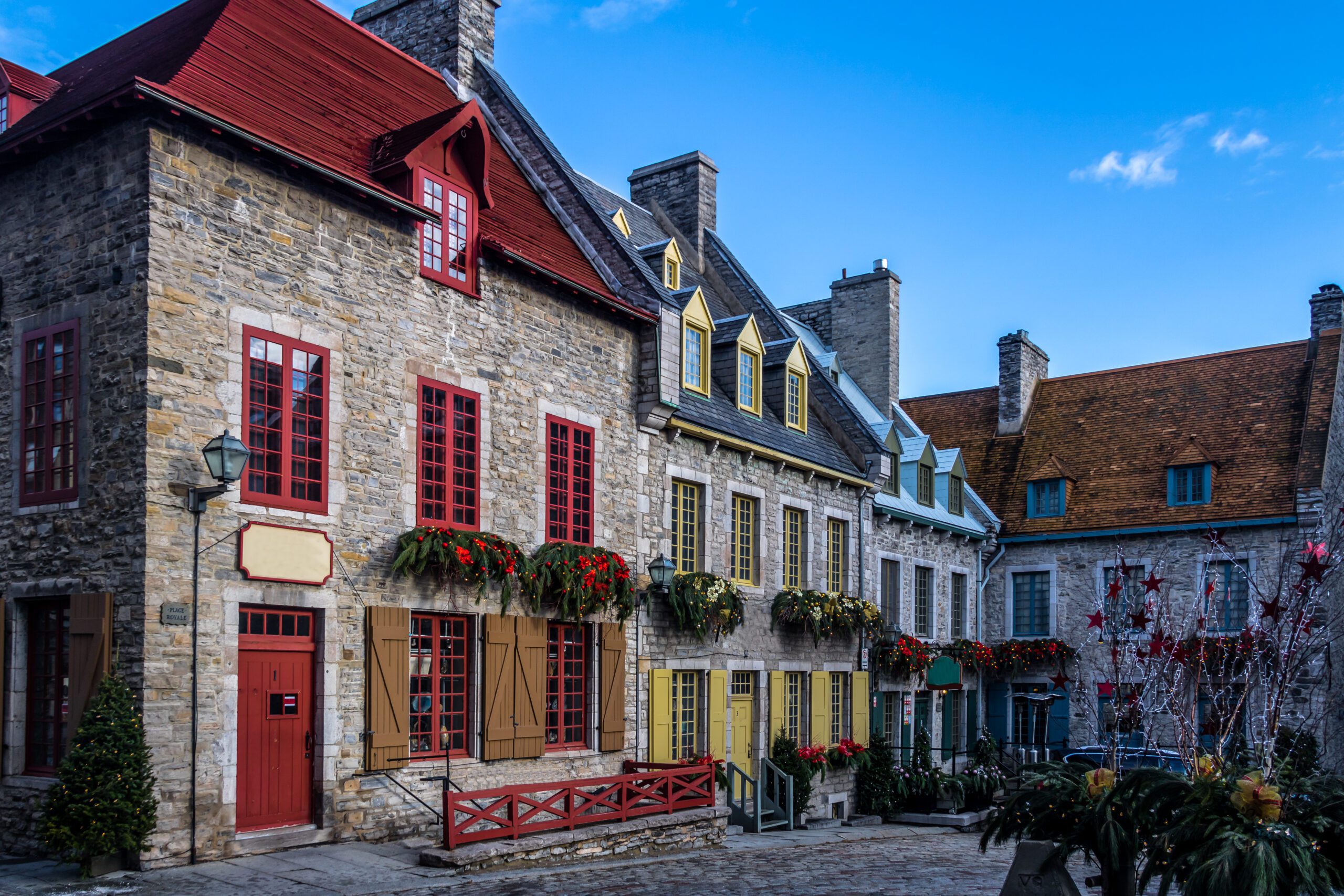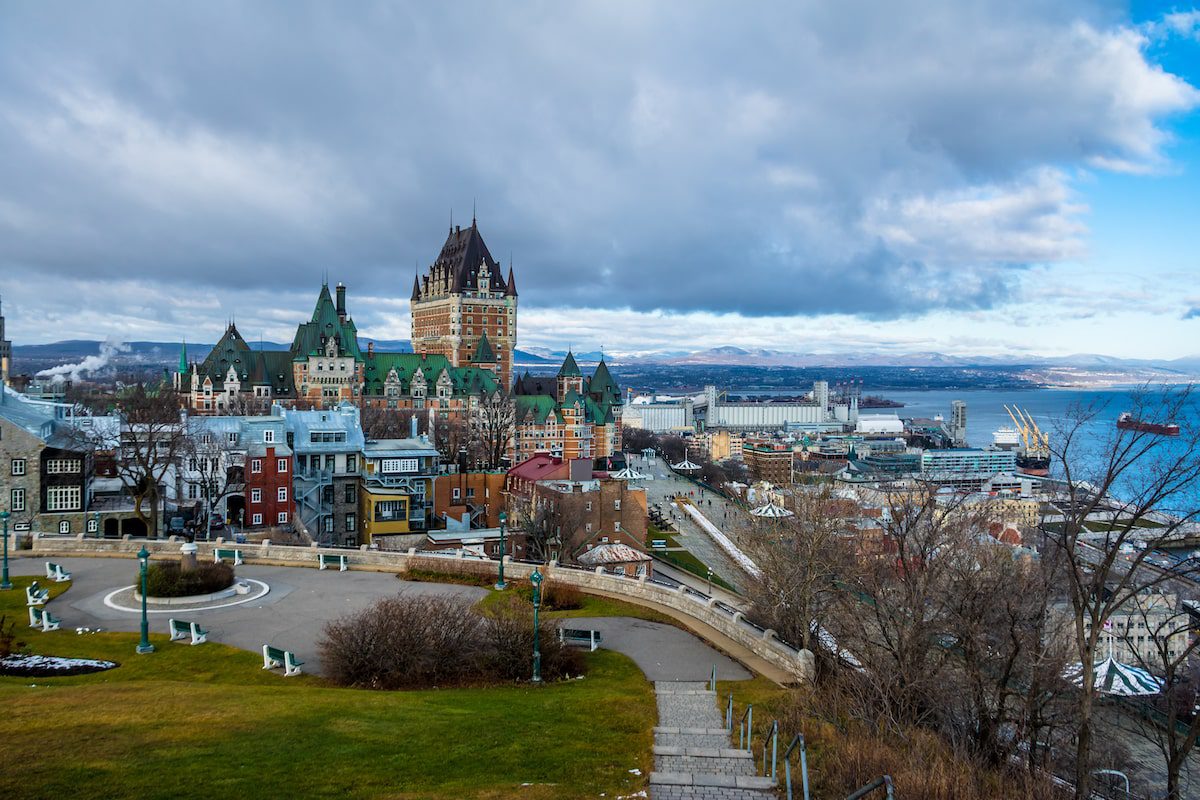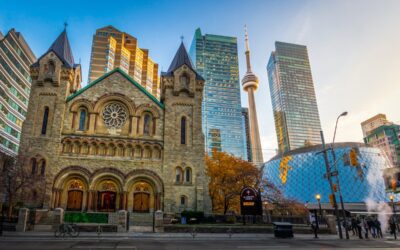Last updated on June 2nd, 2024
Featured image: View of Quebec City skyline with Chateau Frontenac | Photo by diegograndi on Envato
What to see, where to stay, and how to stay safe from a local
by Pamela MacNaughtan
Quebec City is the birthplace of French North America, and the centre of French-Canadian culture and traditions. The streets of the historic district are a living history of the early days of New France, when the Saint-Lawrence River lapped against the houses and Samuel de Champlain’s trading post stood in the spot now occupied by Notre-Dame des victoires.
The Historic District of Old Quebec, a UNESCO World Heritage site since 1985, draws millions of visitors every year. The historic district comprises four neighbourhoods. Upper town (Haute-Ville) is above Cap Diamant cliff, where Fairmont Château Frontenac is perched. Lower town (Basse-Ville) is below the cap and includes Petit-Champlain, Place-Royale, and Old Port (Vieux Port). It’s filled with historic architecture, artisan boutiques, restaurants, art, and fascinating stories.
The high season in Quebec City is June to mid-October and mid-December to early January. It’s a popular cruise destination, especially in autumn when the fall foliage is vibrant and mesmerising. Quebec City is best explored on foot, and there are plenty of stairs and big hills to help one keep in shape. The funiculaire is a good way to travel between the upper and lower towns, especially for those with limited mobility. In summer and autumn, the funiculaire has wheelchair access points on both ends.
I fell in love with Quebec City during a cross-Canada trip. The historic district set off a tingle of excitement, but it was the people, food, culture, and local neighbourhoods that solidified my love for the city. When I decided to reestablish a home base in Canada after years of full-time travel, Quebec City was my first and only choice. Seven years later, I am still struggling with French language skills and encourage everyone I meet to visit Quebec City at least once.
Things to know about Quebec City
- Quebec is a French-speaking province and all signage will be in French-only. While the French language is more prominent here, there are many locals who can speak some English. A smile and a “bonjour” can go a long way, and locals are usually there to help visitors.
- Using a translation app like Google Translate can be helpful in Quebec. While most locals in the old city speak some English, it can be a challenge if you need emergency care. Assessment staff may have very limited English-language skills and paperwork will always be in French.
- Travel insurance is recommended when travelling in Quebec. If you require hospital care, you will need to provide a credit card prior to assessment if you do not have insurance. The exception is residents of Ontario who have OHIP as there is a partnership between Quebec and Ontario for healthcare services. Compare travel insurance rates here.
- A passport is required to visit Canada, and some may need a visa as well. Check this website for up-to-date information on entry rules.
- Quebec uses Canadian currency, and there are ATMs scattered throughout the city. Most places accept major credit cards, but some businesses are cash only. Most will accept US dollars at par.
- Quebec uses the 24-hour clock, while the rest of Canada uses the 12-hour clock. Hours of operation will be listed as 16h30 (4:30 pm).
Safety in Quebec City
Quebec City is considered one of the safest cities in the world, and the safest city in Canada. You can learn more here. It’s the capital of Quebec, with a population of 560,270 (Montreal’s population is 1.8 million). It has a ‘big village’ ambiance, and it’s easy to feel at home here.
As female travellers it is important to exercise caution with valuables, drinks, and personal information. In Quebec City, female travellers can feel safe walking around late at night, and locals are generally happy to help. Pretty crime is uncommon here, and the last major crime event was on Halloween in 2020. (Find safety products recommended by women here.)
Women can walk around the city safely any time of day or night. In Old Quebec, the streets are very quiet after dark, and I have wandered around at 3:00 am without worries on many occasions. If you prefer to travel by taxi late at night, download the taxi coop app to order a taxi without worrying about language barriers.
Many of the city’s homeless residents live in the Saint-Roch neighbourhood, but they don’t harm anymore. At night, many sleep in and around Jardin Jean-Paul-L’Allier or close to the highway overpass at Boulevard Charest.
June 24th is Fête Nationale du Québec, also known as Saint-Jean-Baptiste Day or National Day. It is a celebration of all things Québécoise and the national flag is proudly flown all over the city, and worn on clothing and faces. It’s more popular than Canada Day (July 1st, which is also national moving day in Quebec). Parties begin the afternoon of the 23rd, and everyone’s invited. It is a good time to practice French and learn more about Quebec. Do not bring a Canadian flag or demand locals converse in English, some will not react well.
Read More: Find advice about women’s safety here

Place Royale buildings in Quebec City / Photo by diegograndi on Envato
How to get to Quebec City
Quebec City has a small international airport, Jean Lesage International Airport (YQB). There are direct flights from Toronto, Vancouver, New York City, Fort Lauderdale, and Paris throughout the year. Seasonal direct flights include Chicago, Orlando, Calgary, Charlotte and Cancun. It is a 20-minute drive from Old Quebec City. Taxis offer a flat rate for travel between the airport and Old Quebec/Downtown. During the day (5h to 23h) the fare is 41.40 CAD and 47.60 CAD at night. There is a taxi line outside the airport. There are two bus routes servicing the airport, but both require at least one transfer to get to Old Quebec. Check for flights here!
The best way to travel to Quebec City is by train. VIA Rail’s Ontario-Quebec line makes stops in Montreal, Ottawa, Toronto, Niagara Falls, and a few places in between. Quebec City is also on The Ocean Line, which begins in Halifax and travels to Montreal. Tuesdays are the best time to buy train tickets, and trains are equipped to service passengers with limited mobility and disabilities. CAA members can get an additional 10% train fares for travel in Ontario and Quebec.
If you’re travelling from the United States, Amtrak’s Adirondack Train runs from New York City to Montreal. Once you’re in Montreal, the journey to Quebec City with VIA Rail is only 3.5 hours. Check train schedules and get tickets here!
The Trans-Canada Highway is known as HWY 20 and is a popular route. On the north side of the Saint-Lawrence River, HWY 40 is a popular choice. The most scenic route, and the longest, is Route 138 on the south shore. It’s also known as Chemin du Roy and passes through charming towns and serene farmlands. Once you arrive in Quebec City, it’s best to park your car and navigate the city on foot as street parking is limited and several streets become pedestrian-only in summer. Find a car rental here!
Where to stay
Quebec City has a lot of wonderful accommodation options. Fairmont Château Frontenac is a popular choice, but a short walk across Parc des gouverneurs, is Hôtel Nomad. It’s a beautiful boutique hotel with themed rooms and a lovely morning room. If stairs are a challenge, request a ground-floor room when booking.
Monastère des Augustines is one of my favourite staycation choices. The Augustinian sisters arrived in New France in 1639 and established the first hospitals, including Hôtel Dieu. The monastery is connected to the hospital, and in 2015 it was converted into a wellness retreat, complete with a hotel, museum, archives, health-forward restaurant, and wellness classes. (Read more about Le Monastère des Augustines in our Women’s Travel Directory)
Also in Old Quebec, Hôtel Champlain is on a quiet stretch of rue Sainte-Anne, comfortable, and a short walk from busy rue Saint-Jean. In Saint-Roch, Hôtel PUR is a Marriott Bonvoy member and close to all of the neighbourhood action. In Montcalm, a short walk from Old Quebec, Hôtel Château Laurier is a great place to base yourself. It’s close to restaurants, the Plains of Abraham, and summer festivals.
Read More: Travel Experts Share Hidden Gems in Canada
Places to see and restaurants to dine in
Old Quebec is popular and a must-see, but there is more to see and experience in and around Quebec City. In summer, experience Île d’Orleans on a guided wine tour or cycling tour. Ride a bus to Montmorency Falls and walk along the trails. Wander through neighbourhoods like Saint-Roch and Limoilou for Quebec terroir souvenirs, and go to Montcalm to visit the Musée National des Beaux-arts du Québec.
Click here to find even more things to do in Quebec City.
Quebec City is home to several award-winning restaurants, and its food scene continues to evolve. In Old Quebec, Sagamité is a must for Indigenous cuisine, and Va Bene in Petit-Champlain is a micro-restaurant with one of the best onion soups in the city. In the neighbourhood of Saint-Sauveur, Le Fin Gourmet is run by a mother-daughter team, and a personal favourite. Patente et Machin, also in Saint-So, serves the best sweetbread (ris du veau) in the city. There is always a line up outside Tora-Ya Ramen in Saint-Roch, and the ladies at Nina Pizza Napolitaine learned their trade from a New York City pizzaiolo. Vegans will love the food at Don Vegan in Old Port, and most restaurants have vegetarian-friendly dishes.

Pamela has been a freelance travel and food writer for the last 10 years, writing about travel, culture, and food in Québec on her website, Urban Guide Québec. She has written for Québec City tourism, and updates guidebooks on Montréal, Québec City, and Canada for Michelin and DK Eyewitness.
Montréal is a favourite day trip, often filled with neighbourhood explorations, culture, and a lot of food.
More to Discover From Canada
Indigenous Women in Aviation: Flying the Female Skies
In Canada, Indigenous women are making their presence felt in the aviation industry, which has historically been dominated by men.
Where to Stay in Toronto, Canada: Recommendations From Solo Women
Women share their top choices on where to stay in Toronto, Canada, including hotels, hostels, and affordable options across the city.
The Black Fly in Our Chardonnay: Booze Around the World
Jules Torti and her wife Kim have been on countless adventures in search of booze around the world, from moonshine to craft beers and more!








0 Comments
We always strive to use real photos from our own adventures, provided by the guest writer or from our personal travels. However, in some cases, due to photo quality, we must use stock photography. If you have any questions about the photography please let us know.
Disclaimer: We are so happy that you are checking out this page right now! We only recommend things that are suggested by our community, or through our own experience, that we believe will be helpful and practical for you. Some of our pages contain links, which means we’re part of an affiliate program for the product being mentioned. Should you decide to purchase a product using a link from on our site, JourneyWoman may earn a small commission from the retailer, which helps us maintain our beautiful website. JourneyWoman is an Amazon Associate and earns from qualifying purchases. Thank you!
We want to hear what you think about this article, and we welcome any updates or changes to improve it. You can comment below, or send an email to us at [email protected].